The BRAWL² Tournament Challenge has been announced!
It starts May 12, and ends Oct 17. Let's see what you got!
https://polycount.com/discussion/237047/the-brawl²-tournament
It starts May 12, and ends Oct 17. Let's see what you got!
https://polycount.com/discussion/237047/the-brawl²-tournament
Block in Diablo scene
Hey all, so this is my second crack at an environment (still working on my first). I'm doing this as my first demo reel piece in school, will be starting full steam ahead on it in about 2 weeks after the holidays. I was hoping to get some feedback on my proportions, and low poly block in's. The main object I'm unsure about is the little awning sticking off the building. I'm wondering if I approached it right, or if it should be one piece of geometry with transparency maps.
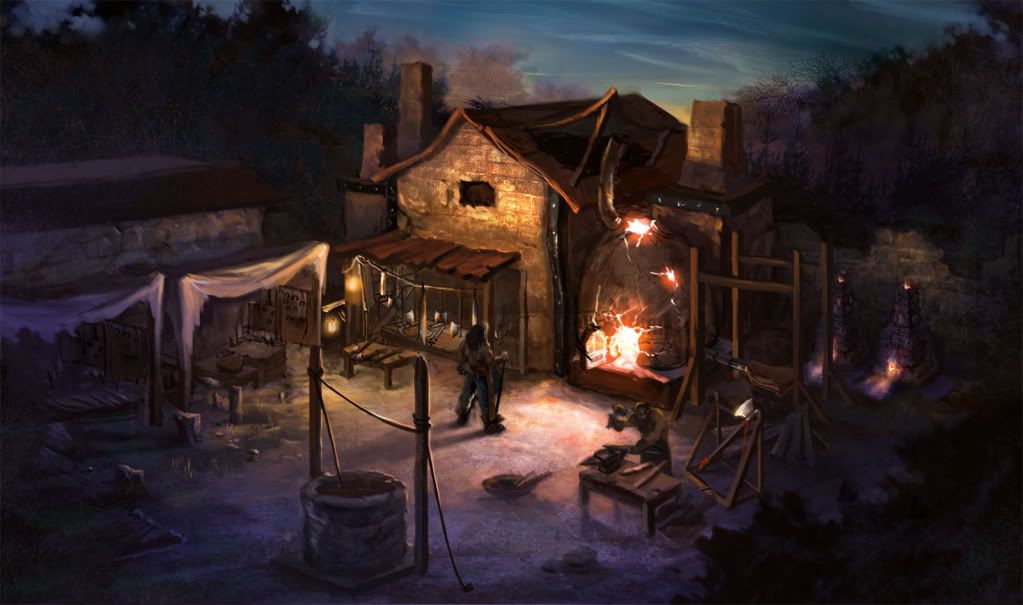
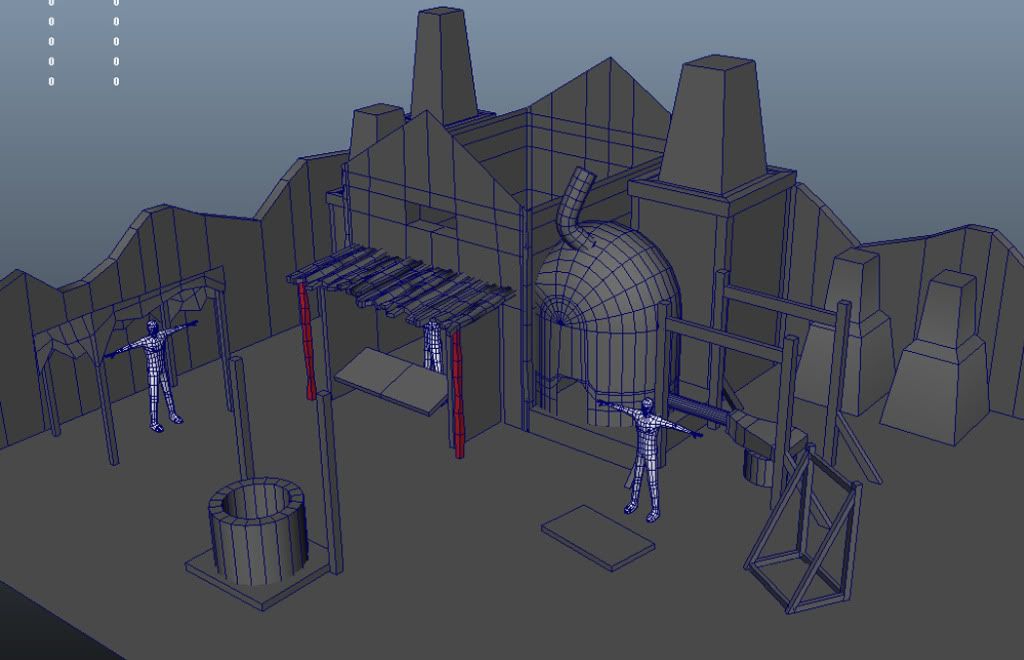
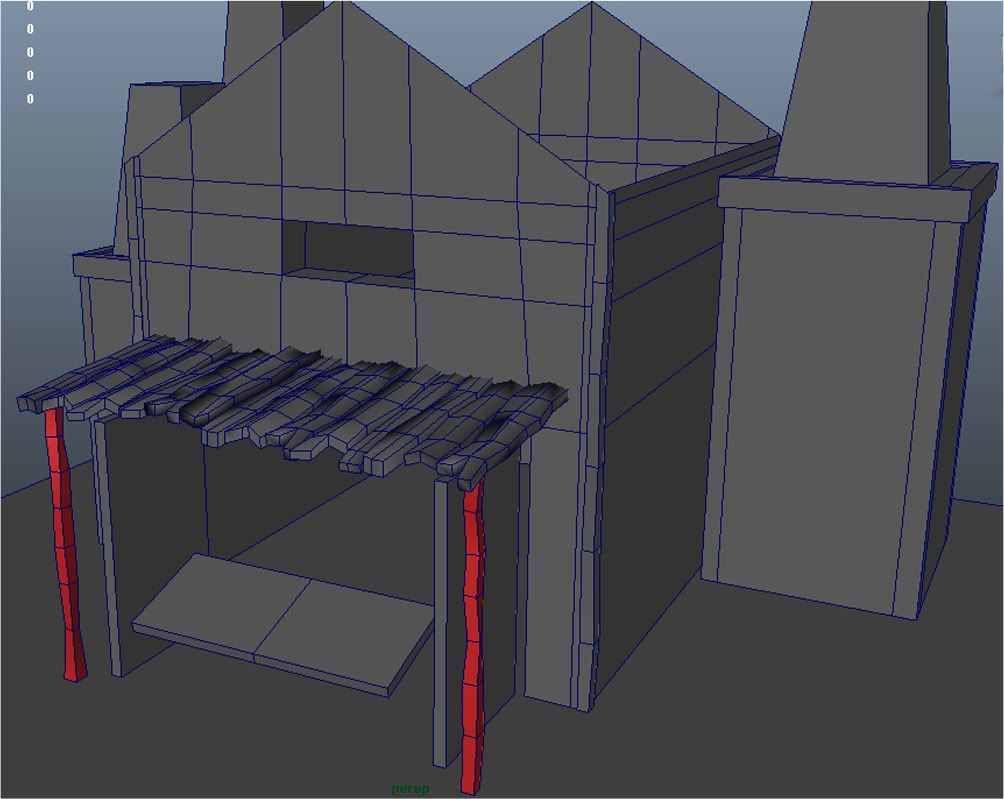
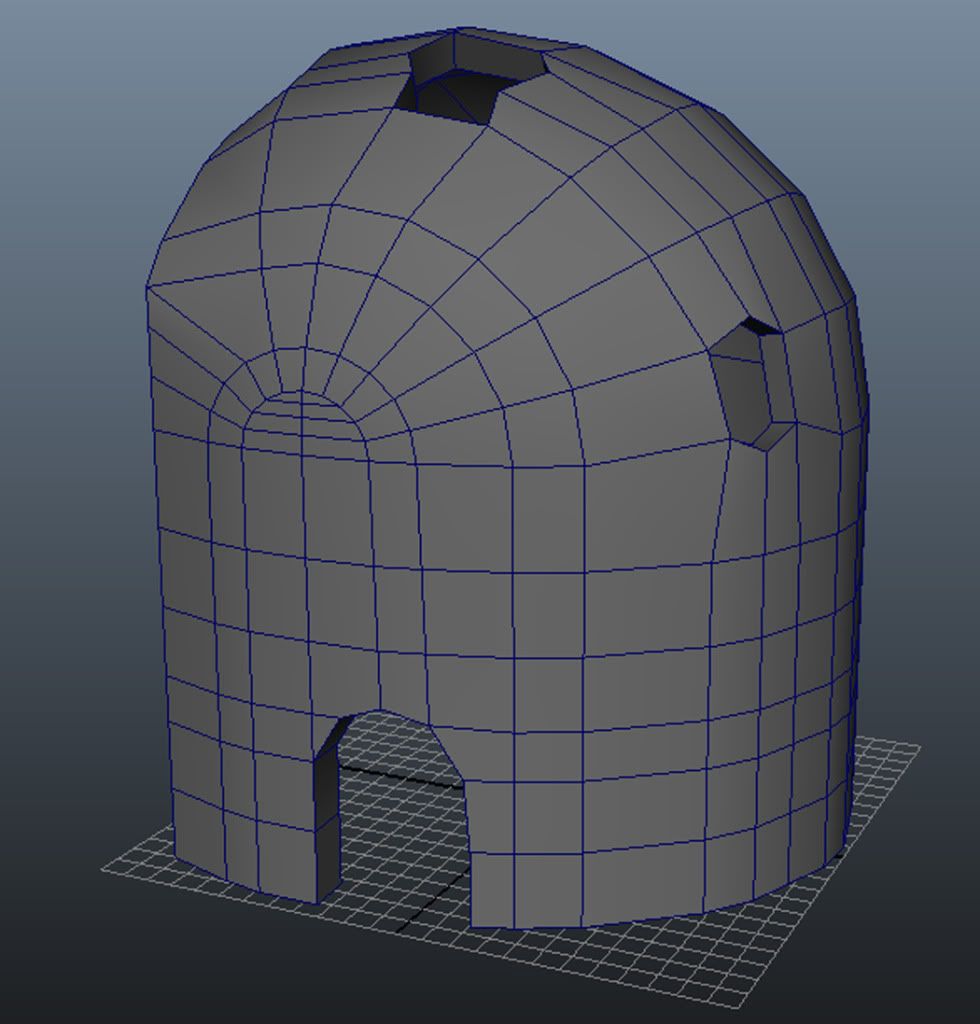
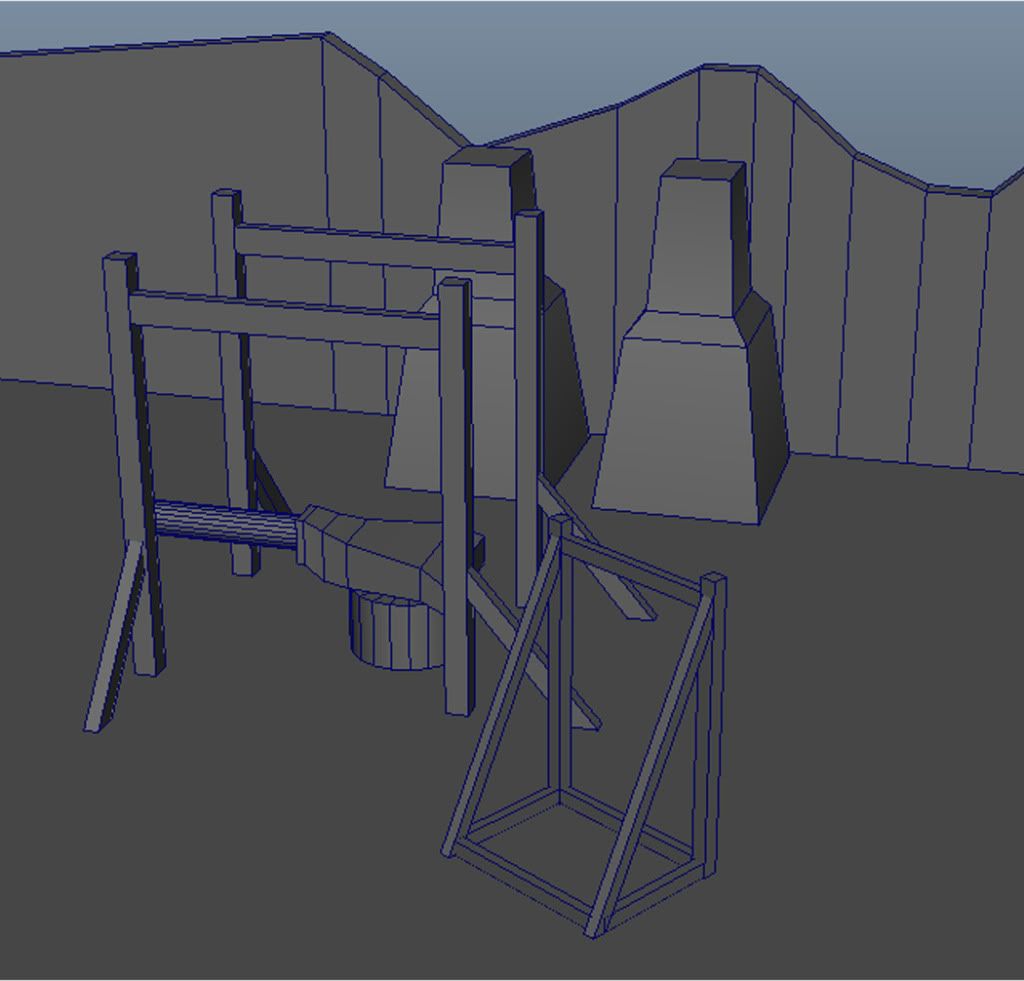





Replies
As far as what you've got so far things are looking alright, for the corners of the store/building you don't need the extra geometry, it's too thin anyways. That can all be in the texture and with a normal map you can show the creases between the braces and the wall.
Other than that, this scene is coming along. The only other thing that really stuck out to me is that you have a cylinder in your scene that is easily pushing twenty divisions. Once again, there is a surprising amount of simplicity with Diablo props, and with the third person style camera you do not really want to push the divisions past 10 for small pipes like the one I am referring to. Keep posting, and I can't wait to see some paint on this scene.
Other than that, i agree that alphas are a bad idea. For the sake of saving a few polygons it's totally not worth it when you consider the average power of a PC these days. With that said though, there's definitely room for a lot of optimisation in your assets, especially in said overhang of the shop and the big stone oven. Remember that your tris only really need to describe the silhouette, anything else is essentially wastage. In a top down scene, this leaves a lot of room for optimisation.
edit : Same thing about polycrunching applies to this axe too, especially considering it's just a bit of the scenery there's a lot of wastage. I did a quick drawover to show you what i mean. Red is suggestions for new topology, green is cut these loops completely. The shape also seems a bit off as well.
@DDuckworth Yes I totally get what you're saying. And I forgot to soften/harden my normals before I posted this, I'll do that on my repost
As for this you are on the right track! Keep up with the good work!
From a Diablo style perspective smoothing errors will be unnoticeable and it doesn't have moving parts, so I think the poles are okay. But I'm a newb.
The point i was trying to get across in my earlier drawover was more that there was a lot room for optimisation rather than advice on topology, infact the topology in what i drew was really sloppy. If its topology advice you're after here's a better example of the kind of poly flow you could aim for dude, clean(er) and low density. I'm no expert though, there's probably a better solution.
Btw, your teacher was probably teaching you to stick to quads because while everything gets triangulated when it's imported into a game engine, quads are much easier to work with when modelling (edgeloops/rings etc). Tris also cause pinching when you subdivide which leads to ugly smoothing errors, and he might have been referring to that. Plenty of reasons. For something like this though where you're aiming for the lowest polycount possible, tris aren't really an issue.
On the door are those door hinges modeled into the door? if so i would make that a seperate model which would save you more triss. Im sure if you look around you'll find some other things aswell.
ohh and a small thing... you wouldn't be able to close your door.
Hope I hellped out a bit, keep up the work!
On this one I placed in red all of the lines you can get rid of/merge and green for where they can/should be. This is a little bit of over-optomizing since that building is very low already but that's due to simplicity, and there is no need to have extra poly's here and there because as the scene fills up it will start to get pretty high. I didn't do EVERYTHING you should do but hopefully you can see where you can merge things from this guide.
First up the roof flap needs thickness, as a rule of thumb that i use, if it's not as thin as paper, and you will see it from the side, never use a single plane of thickness, all items need some thickness to look correct unless you will just never see the side of them, and even then for things like fences it is still somewhat obvious that it's only a plane.
Then there are the green lines coming out of the right and left of the window hole, you don't need that extra ring around the house at the top before it reaches the crest because you only need poly's at edges where things change. since it's not changing from the ring below the edge of the top to the top, you can merge directly to that corner. I know that might be hard to understand but it's the best I can think to describe it.
The rest of the lines I feel are fairly easy to follow, let me know if you have any questions.
Same thing for this one, you don't need edges where the edge doesn't change so you can merge over to the upper one (or lower one as I suggested in this case, doesn't matter) since the edge remains flat. These seem pretty easy to follow as well I hope, i left out the red lines on the outer large green lines because it just made a mess, but you'll be merging the points around that little triangle to the corner of the doorframe.
Another issue is one i've mentioned before is your soft edges, it seems you are setting almost everything to "Edges -> soften normals" which is not good for hard edged objects, you'll need to selectively choose what is hard and what is not. However for preview shots it's probably best you just leave them hard and then soften all of the correct edges once you finish. I usually soften/harden as I go but i sometimes have to end up redoing them so i'm not sure of my own workflow on that one yet.
Finally is the marmoset render, I am really hoping (fingers crossed) that you can tell that the marmoset render looks HORRIBLE. this is simply because I am assuming you exported the model into an OBJ and imported into marmoset, this doesn't always work well and the geniuses over at 8monkeylabs included an exporter for marmoset with the files. The guide to install the exporter from maya to get it into marmoset and have it look correct is in the marmoset folder, usually located C://Program Files (x86 if you are on 64 bit windows)/Marmoset Toolbag and the file is Toolbag User Manual.
The instructions are on page 8 and i have copied the installation instructions here -
1. Copy the appropriate .mll for your version of Maya into your Maya installed
directory, into bin\plug-ins\.
a. Sample file path: C:\Program Files\Autodesk\Maya2010\bin\plug-ins\
2. Copy the stooge.mel script file into any suitable script folder, ideally My
Documents\maya\scripts\.
3. Open Maya. Go to the plugin window (Window->Setting/Preferences->Plug-in
Manager). Search for the "stoogeExport" plugin, and check both the "Loaded" and
"Auto-Load" checkboxes
Just as an example here is what an object brought into marmoset will usually look like without anything on it, the only thing on this object is a normal map, but it should all be nice, white, smooth, and not have crazy colors and artifacts like in your render. I have struggled with the same problem before so I hope this has been a huge help to you!
Good Luck! - Derrick
Thanks again dude! The help is greatly appreciated, and I will most definitely apply all of it, or as much as possible to my scene!
- Jordan
Also DDuckworth, my maya crashes when I try exporting this scene when using the stooge exporter, but I can export objects made in a new scene just fine. Any idea what could be in my scene that would be corrupting it?
that marmoset looks MUCH better! As for the crashing issue I'm not sure, sometimes the things you do in maya can get so convoluted I don't even know. The possible solutions would be to open the outliner, select everything in the scene by doing a click then shift click on the bottom object, and delete->delete by type-> history. i created a shelf button that i click quite often because it's very important to clear history on many objects so that freezes and crashes and oddities don't occur. Then after you've deleted history take everything out of groups by selecting the group then clicking edit-> ungroup groups can often cause odd things when exporting to engines or using external scripts. Especially groups that were created automatically by merging and separating groups of geometry.
If none of that works you can always just select every visible object in your scene, then click "Export Selected" and export it to a new file, this will get rid of any unseen things that may be causing problems usually.
Let me know if any of this fixes the problem! Good luck texturing
As far as sites i've always wondered myself if there were any good ones like that, I haven't really found any, one good secondary though that I can semi rely on is deviantArt, they have a resources->stock images-> textures category and lots of people upload custom sets of textures there, it's very hit and miss but you can often find very unique pieces there that your classmates will certainly not be using. Oh also a good google search tip is when searching images for texture resources, go to search tools "Largest" or "Larger Than" and set a size for the minimum image that comes up, this will save you tons of time when going through images. Sometimes I revert to the awful bing if i find a photo I really like that is too small because when you search a word like wood, then find a picture you like and it's only 200x200, you can click "find similar images" which will then load up every copy of the same image of all of the different sizes bing can find, and this has made me sigh in relief more than once. Hope that helps!
- Jordan
i would rather just grab my work and stick it in cryengine or something nice and quick to export stuff into.
unless of course your school wants you to learn to make renders for a game course. in which case i would question that somewhat.
also, you are currently spending a lot of polies on things that really don't need it, i think you are missing the essence of a low poly scene - and while we don't really have to worry about polies so much these days, i think it's still vital to be able to spend your polies as wisely as possible. a clean mesh equals a clean heart. or something.
i think duckworth is giving you some fantastic crits and you need to step back and really analyze your project once you're done with it. rip it apart and remove edge loops, collapse and weld things, try and optimise it as much as you possibly can, and then go a step further.
don't worry about destroying your work and don't worry about your current piece not being the greatest thing you've ever made, as long as you can learn something from it at the end you've won half the battle.